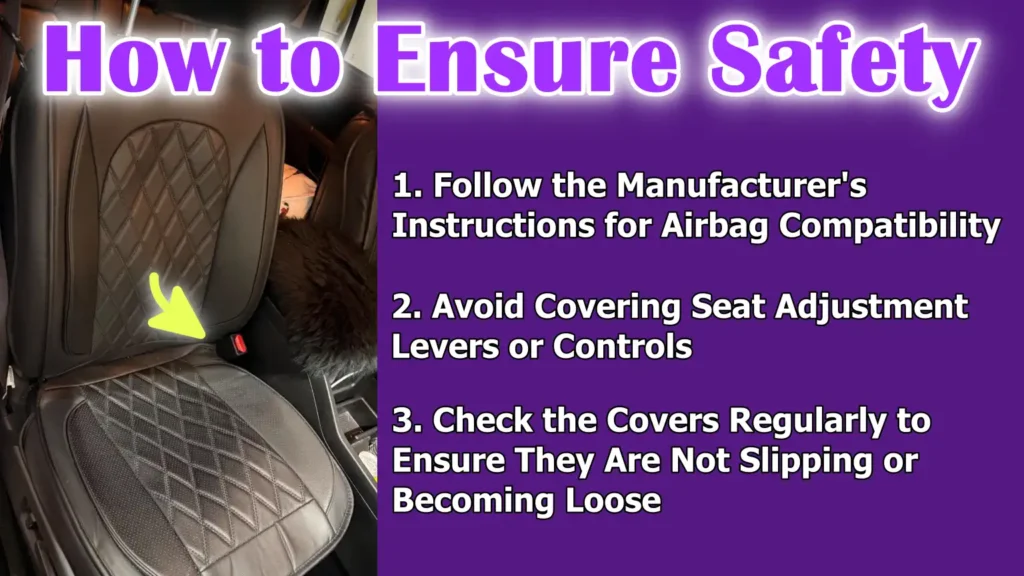Written By: Don Dodi
Fact Checked By: Kristen Brown
Reviewed By: Diego Rosenberg
It is the fact that your car seats actually aboard more sweat, dust and UV damage than almost any other part of your vehicle’s interior and you can prevent these things just by installing car seat covers, as simple as you like.
Which is why, car seat covers are more than just an ordinary accessory, as it protects your expensive car seat and enhances the appearance as well.
Plus, automotive interior studies also shows that: car seats are one of the most used and most quickly worn-out parts of a vehicle, as they have to deal with direct exposure to dirt, sweat, UV rays, food spills and even pet hair as well.
So, when you install the seat covers then it can even extend the life of your original upholstery as it reduces the wear and tear and that improves the resale value of your car as well.
Along with this, now-a-days modern seat covers are made with materials such as: Leatherette, Neoprene or Breathable Fabrics which are actually designed to resist stains, water and fading as well.
Also, you can personalize your vehicle’s interior with some style as well and you don’t have to go with the expensive re-upholstery option.
That’s why this guide shows you comfortable way on How to Install Car Seat Covers, so that you can upgrade car’s interior and keep that fresh looks for years.
Tools
| Tools/Materials | Purpose/Use | Tips/Notes |
|---|---|---|
| Seat Covers | Protects original seats from dirt, spills, wear and UV damage. Can also change the style of a car’s interior. | Choose covers that suit your car model for best results. Universal covers may work, but may require additional adjustment. |
| Scissors | Used to trim excess fabric or adjust straps if necessary. | Trim only a small amount at a time to avoid mistakes. Some covers don’t require trimming. |
| Hooks, Straps, or Velcro | Keeps seat covers securely under or around the seats. | Most covers include these. Be sure to fasten tightly to prevent slipping. |
| The Instruction Manual | guides you step-by-step through the installation process. | Even if installing the cover seems easy, always read it first. The manufacturer’s advice can save time and prevent damage. |
| Optional: Cleaning Cloth/Vacuum | Prepares the seats for installation by removing dust, dirt, or crumbs. | Clean seats make installation easier and help the seat cover last longer. |
| Optional: Headrest Cover | Protects the headrest and completes the look of the seat cover. | Some sets include these. Make sure they fit snugly on the headrest. |
How to Prepare First for Seat Cover Installation
1. Clean the Car Seats
Before installing seat covers, it’s important to thoroughly clean your car seats.
Dust, crumbs and dirt can cause covers to fit poorly and can scratch or damage them over time.
Use a vacuum cleaner to remove loose dirt from every corner of the seats.
After vacuuming, wipe the surface with a clean, damp cloth to remove any remaining dust, sweat stains, or spills.
Clean seats allow the covers to stay in place easily, making seat cover installation easier and ensuring their longevity.
2. Remove Headrests and Detachable Armrests
Many car seats have removable headrests or armrests and removing them before installation makes the process easier.
The headrests can be removed separately and reinstalled after the main seat cover is installed.
Detachable armrests, if left on, can cause wrinkles or uneven areas in the seat cover.
Removing these parts first ensures a better fit of the seat cover, improving both its appearance and comfort.
3. Identify Front and Rear Seat Covers
Car seat covers often come in sets with separate parts for the front and rear seats.
Before you begin, identify which cover is for which seat.
Front seat covers are usually smaller and may have special holes for seat belts or airbags, while rear covers are larger and sometimes divided into multiple parts to fit the backrest and seat cushion.
Knowing this in advance saves time and avoids mistakes during installation, ensuring that each cover fits properly and provides optimal protection.
How to Install the Front Seat Cover
1. Slide the cover onto the back of the seat
The first step in installing the front seat cover is to carefully slide the cover onto the back of the seat.
Start at the top edge and slowly pull it down over the seat, ensuring the cover is centered and aligned with the seat’s contours.
This step is crucial because a well-aligned cover prevents wrinkles and ensures a smooth fit.
Proper alignment also helps maintain the functionality of any built-in airbags or seat adjustments.
2. Pull the cover evenly down the seat’s contours
Once the cover is in place on the back of the seat, gently pull it down evenly toward the bottom cushion.
Adjust the fabric around the seat’s curves and contours to create a comfortable and smooth look.
Most modern car seats have curved designs for comfort and the cover should conform to these contours to avoid bunching or loose areas.
Taking the time to properly adjust the fabric ensures that the seat cover looks neat and stays in place during regular use.
3. Tuck the fabric of the cover into the crevices
After pulling the cover down, tuck the excess fabric into the crevices between the seat back and the bottom cushion.
This step secures the cover, prevents slipping and prevents it from moving when you sit.
Tucking it properly also secures the seat edges and helps maintain the cover’s clean, custom-fit look.
Paying attention to this step will make the universal seat cover look like it was custom-made for your car.
4. Install straps, hooks, or Velcro under the seat
Most seat covers come with straps, hooks, or Velcro to hold them in place.
Tuck these pieces firmly under the seat, ensuring they are tight but not stretched.
Installing the cover correctly prevents it from slipping or bunching, which can be unsafe, specially when entering or exiting the vehicle.
Following the manufacturer’s instructions for installing these straps ensures long-term durability and stability.
5. Replace and Cover the Headrests
Finally, replace the headrests and cover them with any headrest covers.
Headrests are essential for safety and comfort and covering them gives the seat a uniform appearance.
Ensure the headrests fit snugly into the covers and don’t overstretch the fabric.
This final step completes the installation of the front seat covers, leaving your seats clean, safe and stylish.
How to Install Rear Seat Covers
1. Fold the Rear Seats If Possible
Before beginning installation, if your vehicle allows it, it’s helpful to fold the rear seats.
Folding the seats provides easy access to the backrests and bottom cushions, making it easier to install and adjust the covers.
This step also ensures that the covers fit snugly and reduce the chance of wrinkles or looseness.
Furthermore, folding the seats makes it easier to access the straps, hooks and Velcro underneath, which are essential for secure installation.
2. Install the Backrest Covers First
Start by placing the backrest covers on the rear seat backs.
Carefully align the covers with the contours of the seat and ensure they fit evenly on both sides.
Most covers come with straps that can be threaded through the seat backs or attached to the seat frame.
Securing the backrest covers first ensures a proper fit and creates a sturdy base for the bottom cushion covers.
A well-fitted backrest cover prevents slipping and improves the overall appearance of the rear seats.
3. Install the Bottom Cushion Cover
After installing the backrest cover, install the bottom cushion cover.
Pull the cover over the seat cushion and insert any straps or attachments into the gap between the backrest and seat base.
Proper alignment is essential to prevent the fabric from bunching or sagging.
The bottom cushion cover protects one of the most used parts of the rear seats and prevents wear and tear over time.
4. Tighten the Buckles, Hooks, or Velcro
After installing both covers, fasten all buckles, hooks, or Velcro under the seats.
Ensure each strap is tight and secure so the cover doesn’t move when passengers get in or out of the car.
Proper installation not only enhances the beauty of the seat cover but also contributes to safety by ensuring the fabric doesn’t interfere with seat operation or seat belts.
5. Replace the headrests and cover them if necessary
Finally, replace the removed headrests and cover them with matching headrest covers, if available.
Headrests are crucial for comfort and safety and covering them ensures a uniform and shiny finish on the rear seats.
Ensure the fabric fits snugly over the headrests without stretching or tearing, ensuring a neat, secure and stylish finish for the rear seat cover installation.
Read More:
How to Do Adjustment and Final Steps
1. Smooth out wrinkles or loose fabric
After installing the seat covers, it’s important to carefully smooth out any wrinkles, folds, or loose areas in the fabric.
Wrinkles not only make the seats look untidy but can also cause discomfort when sitting.
Folding and adjusting the covers to the size of the seat ensures a comfortable and smooth fit.
This step also helps the seat covers maintain their shape over time and prevents uneven wear caused by constant movement or friction.
2. Ensure No Obstructions in Seat Belts and Airbags
Safety is an important consideration when adjusting seat covers.
Ensure the covers don’t block the seat belts, buckles, or side airbags.
Most modern seat covers are designed with openings or flaps to properly deploy the airbags in the event of an accident.
Keeping these areas clean maintains your vehicle’s safety features and can prevent accidents or malfunctions caused by improperly installed covers.
3. Recheck the Tightness of Straps and Hooks
Finally, check all straps, hooks and Velcro to ensure they are securely fastened.
Loose straps can cause the cover to slip, move, or bunch up while driving, which can be both inconvenient and unsafe.
Pull each strap firmly and tighten all hooks and Velcro, double-checking under the seats and around the backrests.
This final step ensures that the seat covers stay in place, providing maximum protection, comfort and a neat, professional look for years to come.
How to Ensure Safety

Along with this, when you select the seat covers, you should consider the comfort as well, as the study also highlights the important of fabric properties such as: air permeability and moisture resistance that enhances the occupant comfort. So, you can go with the innovative designs, such as the incorporation of a middle layer with force convection, as it can further improve the effectiveness of seat covers and that maintain the comfort during extended periods of use.[¹]
1. Follow the Manufacturer’s Instructions for Airbag Compatibility
One of the most important safety precautions when installing car seat covers is to ensure they are compatible with your vehicle’s airbags.
Many modern cars have side or seat-mounted airbags that deploy in the event of a collision.
Covering or blocking these airbags can prevent them from functioning properly, increasing the risk of injury.
Carefully read the manufacturer’s instructions before installing any seat covers and only use covers that clearly state they are airbag-compatible.
This ensures that your seats remain safe and your safety features remain fully functional.
2. Avoid Covering Seat Adjustment Levers or Controls
Seat covers should never obstruct seat adjustment levers, recline handles, or other control mechanisms.
Closing these levers can make it difficult to adjust the seat to a comfortable or safe position while driving.
This can also put unnecessary pressure on the seat cover, causing it to tear or wear out quickly.
Position the covers so that all levers and controls are easily accessible, ensuring comfortable and proper operation of your vehicle’s seating system.
3. Check the Covers Regularly to Ensure They Are Not Slipping or Becoming Loose
Over time, regular use, frequent movement, or friction from passengers can cause seat covers to slip or become loose.
It’s important to regularly check your seat covers to ensure they remain tight and secure.
Adjust the straps, hooks, or Velcro as needed to ensure the seat covers fit properly.
Regular maintenance not only keeps the seats clean, but also ensures that the covers continue to provide protection without interfering with safety features, comfort, or vehicle operation.
Conclusion – How to Install Car Seat Covers
So, a well-protected car interior is a long-term investment that enhances comfort, safety and vehicle value as well and it keeps the seats clean, secure and you can style it according to your preferences.
Properly fitted covers provide protection against dirt, spills, sweat, pet hair and everyday use, extending the life of your original upholstery and maintaining your car’s value.
Through careful preparation, accurate installation and regular maintenance, you ensure covers remain secure, strong and functional and don’t interfere with seat belts, airbags, or seat adjustments.
Beyond protection, seat covers offer the opportunity to personalize your car’s interior with colors, patterns and materials to suit your style.
Taking the time to choose the right cover, carefully applying it and following safety precautions can make your driving experience more comfortable, your seats longer-lasting and your car cleaner and more attractive for years to come.
So, that’s all from this guide and you can ask unsolved questions in the comment box.
Frequently Asked Questions
Q1. What types of car seat covers are available?
Answer: There are many types of car seat covers. Some are made of leather or leatherette, which are stylish and easy to clean. Cloth or fabric covers are breathable and comfortable, specially in hot weather. Neoprene covers are water-resistant and durable, ideal for families with children or pets. You can also find universal covers that fit most car seats and custom-fit covers designed specifically for your vehicle model. Each type offers varying levels of protection, comfort and style.
Q2. Can car seat covers affect airbags or safety features?
Answer: Yes, if seat covers are not designed to be airbag-compatible, they can affect airbag deployment. Many modern cars have side or seat-mounted airbags that deploy in the event of a crash. Using covers that block or obstruct these airbags can reduce their effectiveness and pose a safety risk. Always use covers labeled as airbag-compatible and follow the manufacturer’s instructions to ensure that all safety features, including seat belts and adjustment levers, remain fully functional.
Q3. How do I clean and maintain car seat covers?
Answer: The cleaning method depends on the seat cover material. Cloth or fabric covers can usually be vacuumed and wiped with a damp cloth, or in some cases, removed and machine washed according to the instructions. Leather or leatherette covers should be wiped with a soft cloth and mild cleaner. Neoprene covers can also be cleaned with water and mild soap. Regular maintenance, such as checking for loose straps and smoothing out creases, helps the cover stay in place and last longer.
Q4. Are car seat covers difficult to install?
Answer: Car seat covers are generally designed to be easy to install and most can be installed without professional assistance. Proper preparation, such as cleaning the seats and removing headrests or armrests if possible, makes this process easier. Covers usually come with straps, hooks, or Velcro to secure them in place. Following step-by-step instructions ensures a comfortable fit that protects your seats and looks neat. Universal covers may require minor modifications, while custom-fit covers are designed to match your seats exactly.
Q5. Do car seat covers increase comfort?
Answer: Yes, many seat covers are designed to provide additional comfort to your seats. They may contain padding, soft fabric, or ventilated material that reduces sweating during long trips. Some covers are specifically designed for ergonomic support, which can help reduce fatigue on long trips. In addition to comfort, they also keep your seats clean and in better condition, indirectly improving your driving experience.
References:
[1] The Study of Fabric Performance for Car Seats
https://www.researchgate.net/publication/320061441_The_Study_of_Fabric_Performance_for_Car_Seats

Guys, I’m a car audio enthusiast and customization expert and I love clear sound and clean installation. Plus, I have spent years helping people build their dream audio setups. And whenever I’m working on cars, I probably listen to music and thinks about the next big upgrade.

